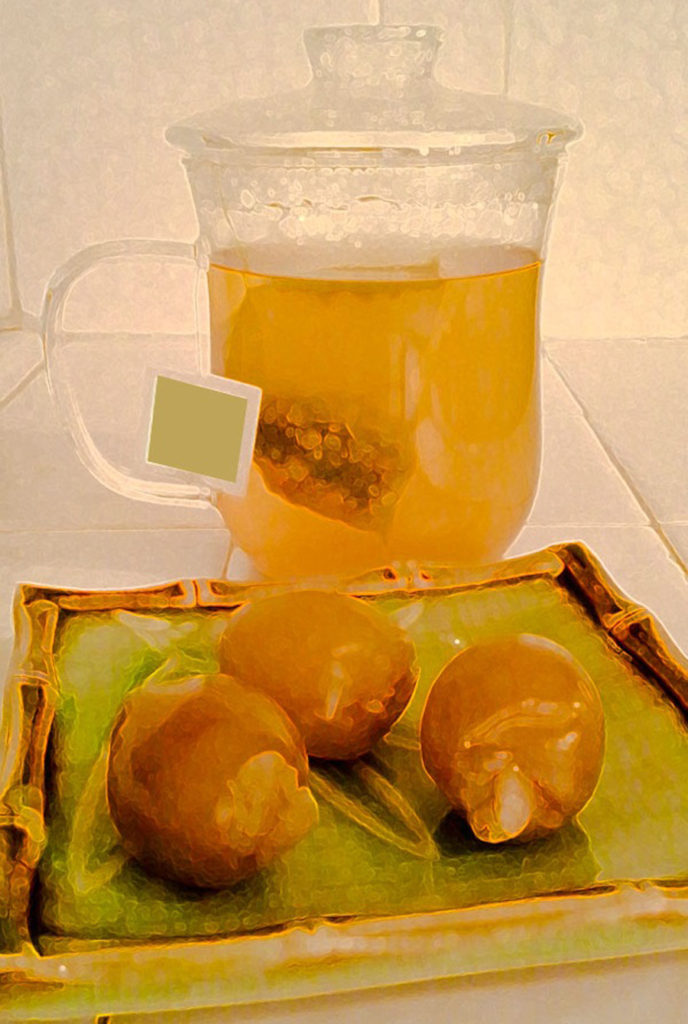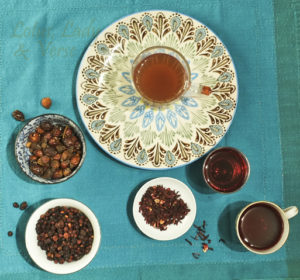Why not combine broth with ginger tea?

You’ll maximize vitamins and minerals in the broth and at the same time get longevity-strengthening benefits from herbs and spices like ginger, nettles, or dried berries.
This recipe is for one cup. You can multiply it to suit for the amount you wish to consume.
Keep in mind that homemade broth lasts three or four days in the fridge, but herbal tea is really best within 24 hours. That’s okay because you want your Broth n’ Ginger Tea fresh and spicy!
Ingredients:
1 ¼ cup vegetable broth (preferably homemade, or if not, unsalted is best)
1 inch knob of fresh ginger root.
Prepare your ginger by peeling it and cutting along the grain in two or three pieces.
You’ll simmer these ingredients to decoct them. To decoct an herb or spice means to cook at below boiling for a specified amount of time. With this technique, you can bring out the taste and vitality of an herb or spice, while retaining as much liquid as possible.
Instructions: make a decoction of your ginger
Place ginger and broth in a heavy pan with lid. Bring broth and ginger slices to simmer, cover and allow to lightly boil for 15-20 minutes. If the liquid comes to a rolling boil, open the lid to allow steam to escape, and turn the heat down. Keep the cooking process longer on lower heat, rather than shorter and hotter, which boils out the broth. During the decoction, some of the liquid will reduce to slightly less than 1 cup.
Turn off the heat and strain into a mug. Allow to cool slightly, and serve.
Wow! The taste is fantastic! if you love ginger. But please read the following note:
Please Note:
If you generally have a hot constitution, or in Ayurvedic terms are more Pitta (like Fire) than Vata (Air) or Kapha (earth), your physical nature may already be too warm for ginger. You can tell this if your face gets red upon ingesting spicy food, or if you need less warm clothing when inside because you’re already well-heated.
Instead, consider adding rose hips, or berries (see below) to your broth, decocting for the same amount of time.
Otherwise, if Asian flavors are your favorite, please see Savory, below.
Berries add phytonutrients and vitamins.
Choose from this selection, or add some that you like. These berries will add a sweet-sour note, and lend a brilliant red color to your tea-broth.

Hawthorn – 1 teaspoon – 1 tablespoon per 1 cup broth
Schisandra – 1 teaspoon – 1 tablespoon per 1 cup broth
Elderberry – 1 teaspoon – 1 tablespoon per 1 cup broth
Savory Taste without Decocting:
For a more savory tasting broth, consider adding 1 teaspoon of miso, and one scallion–the white and green parts, chopped fine, to your broth base. These ingredients should not be boiled at all, but added when the broth is ready to serve, when it’s very hot, but not boiling. Allow the broth to sit undisturbed in your pan for a few minutes before pouring into a mug. Enjoy!
If you have dried nettles this time of year, why not add them to your broth? You’ll want to infuse nettles. Add your nettles when your broth is being heated, at the boiling point. Then, turn off heat and stir the nettles in. Allow your tea-broth to rest, covered, for 15 minutes or more. For dried green herbs, use 1 teaspoon to 1 tablespoon per 1 cup of broth.
This recipe is for information only, consists entirely of my opinion, and is not intended as dietary or medicinal advice or instruction.
Follow


